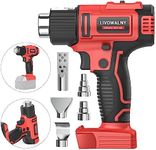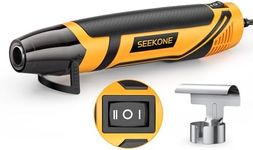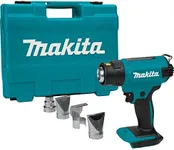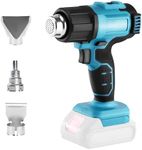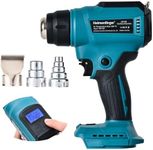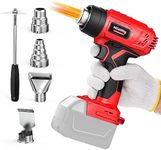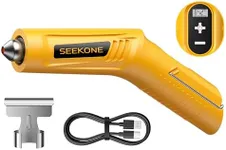Buying Guide for the Best Cordless Heat Guns
Choosing a cordless heat gun can be a bit overwhelming, but understanding your needs and the key features will help you make the right choice. Cordless heat guns are great for tasks where portability and freedom from power cords are important, such as working outdoors, on cars, or in places without easy access to outlets. Before buying, think about what projects you’ll use it for, how often you’ll need it, and what kind of materials you’ll be working with. This will help you focus on the features that matter most for your situation.Battery Type and CapacityThe battery type and capacity determine how long your cordless heat gun can run and how powerful it is. Most cordless heat guns use lithium-ion batteries, which are lightweight and recharge quickly. Battery capacity is measured in ampere-hours (Ah); higher numbers mean longer run times. If you plan to use the heat gun for long periods or heavy-duty tasks, look for a higher capacity battery. For occasional or light use, a lower capacity may be enough. Consider whether you already own compatible batteries from other tools, as this can save money and make charging more convenient.
Temperature RangeThe temperature range tells you how hot the heat gun can get, which affects what kinds of jobs it can handle. Lower temperatures (around 200°C/400°F) are good for gentle tasks like shrinking plastic or thawing pipes, while higher temperatures (up to 600°C/1100°F) are needed for stripping paint or loosening rusted bolts. Some heat guns offer adjustable temperature settings, which give you more control. Think about the toughest job you’ll need to do and make sure the heat gun can reach that temperature, but also consider if you need lower settings for delicate work.
Airflow SettingsAirflow, usually measured in liters per minute (L/min) or cubic feet per minute (CFM), affects how quickly and evenly heat is delivered. Some heat guns have fixed airflow, while others let you adjust it. Higher airflow is useful for large surfaces or quick jobs, while lower airflow is better for precision work. If you need versatility, look for a model with adjustable airflow. Match the airflow to your typical projects: high for big, fast jobs, and low for careful, detailed work.
Size and WeightThe size and weight of a cordless heat gun affect how comfortable it is to use, especially for long periods or in tight spaces. Lighter, more compact models are easier to handle and less tiring, but may have less power or shorter battery life. Heavier models might be more powerful but can be harder to maneuver. Think about where and how you’ll use the tool—if you’ll be working overhead or in awkward spots, a lighter model is better. For bench work or heavy-duty tasks, a larger model might be worth the extra weight.
Nozzle AttachmentsNozzle attachments help you direct heat more precisely or spread it over a wider area. Common types include concentrator nozzles for focused heat, reflector nozzles for pipes, and wide nozzles for large surfaces. Some heat guns come with several attachments, while others offer them as extras. Consider what kinds of projects you’ll do—if you need to work in tight spots or on specific shapes, make sure the heat gun supports the right nozzles. Having the right attachments can make your work faster and safer.
Safety FeaturesSafety features like overheat protection, cool-down modes, and trigger locks help prevent accidents and extend the life of your heat gun. Overheat protection automatically shuts off the tool if it gets too hot, while cool-down modes let the gun cool safely after use. Trigger locks can prevent accidental activation. If you’re new to heat guns or will be using them in busy environments, these features are especially important. Always consider safety as a top priority, especially if you’ll be using the tool frequently or around others.
